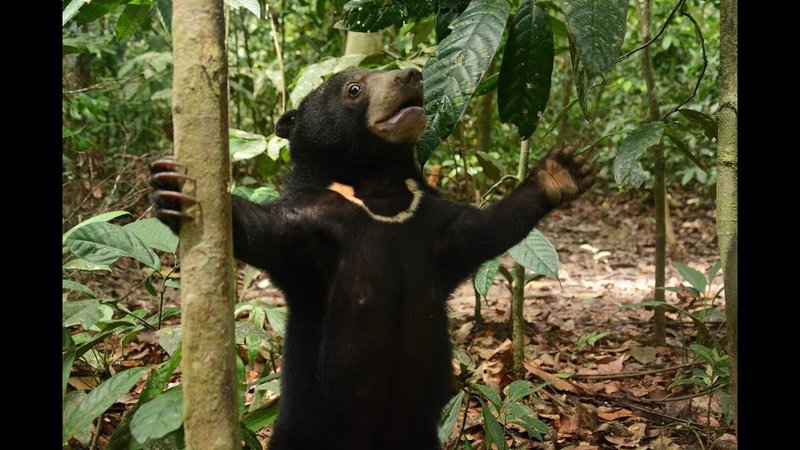
You might be wondering what makes sun bears so special. In many ways, they are the black sheep of the bear family. Unlike their bigger relatives, sun bears are small, have a distinctive golden patch on their chest, and possess impressive intelligence. Have you ever tried to figure out if your pet is smart? Analyzing sun bear behavior can feel a bit like that, watching how they interact with their environment and fellow bears. Let’s dig deeper into their cognitive world, exploring how these adorable creatures think, learn, and adapt.
What Are Sun Bears?
Before diving into their intelligence, let’s get a better picture of what sun bears are all about. Sun bears, known scientifically as *Helarctos malayanus*, are the smallest bear species, typically weighing between 60 to 150 pounds. Their short, sleek fur is usually black, accented with that eye-catching chest patch that varies in color from white to gold. They’re mostly found in tropical forests across Southeast Asia, from Cambodia to Malaysia.
In the wild, their diet consists of fruits, insects, and small vertebrates, showcasing their adaptability. With their long tongues (up to 10 inches!), they can extract honey from beehives and grab insects from hard-to-reach places. This quirky feeding method not only highlights their physical traits but also their problem-solving skills. Honestly, watching a sun bear tackle a beehive is like watching a kid trying to reach a hidden toy—full of determination and clever moves!
Sun Bear Cognitive Abilities
So, how smart is a sun bear, really? Research suggests they have remarkable cognitive abilities that often surprise scientists. One notable aspect is their problem-solving skills. Sun bears demonstrate a keen ability to navigate challenges in their environment, whether it’s opening a tough fruit or figuring out how to access food hidden by zookeepers.
While we don’t have extensive studies specifically on sun bears compared to dogs or primates, their curiosity and adaptability shine through in various observations. For example, in captivity, they’ve been known to learn new tasks quickly, showing that their intelligence is comparable to that of other bear species. They can even remember routines and recognize keepers, which is similar to how dogs bond with their owners.
Social Intelligence
Sun bears exhibit interesting social behaviors that point toward a level of social intelligence. While they are generally solitary creatures, they can coexist peacefully with other sun bears in certain environments. Observing their interactions can reveal a lot about their emotional intelligence. They communicate through vocalizations, body language, and scent marking, which indicates their awareness of each other.
In some cases, sun bears show playful behavior, especially when they’re young. This playful nature isn’t just for fun; it plays a crucial role in learning essential survival skills. Whether they’re playing tag or wrestling, these interactions help young bears develop confidence and hone their problem-solving skills.
Memory and Learning
Like a child learning through exploration, sun bears also have fascinating memory capabilities. Experiments have shown that they can remember tasks and locations of food sources for extended periods. This ability is vital for their survival, especially when foraging for food in a vast jungle.
Additionally, they can learn from watching others, which is another sign of intelligence. When one bear figures out how to access a treat, others often follow suit. It’s like a game of follow-the-leader, where the leader just happens to be a clever bear! Such observational learning is essential for adapting to their environment and ensuring they can find food sources efficiently.
The Role of Curiosity in Sun Bear Behavior
Curiosity is a major part of sun bear behavior, driving their exploration of the world around them. You might notice that they often investigate their surroundings, sniffing out new scents and checking out unusual objects. It’s this curious nature that leads them to discover new food sources and environmental opportunities.
In captivity, zookeepers often provide enrichment activities to stimulate their minds. Think of it as a bear version of a puzzle, where they have to figure out how to get to hidden treats or toys. These activities not only keep them entertained but also encourage mental engagement—similar to how we enjoy playing games to keep our minds sharp!
How Environmental Factors Affect Intelligence
It’s interesting to note that a sun bear’s intelligence can be influenced by its environment. In the wild, they face challenges daily that promote learning and adaptation. While bears in captivity can still show impressive cognitive abilities, their learning might differ because they lack the same challenges.
The variety in their diet, the complexities of their habitat, and the need for survival all contribute to fostering their intelligence. In settings where these factors are diminished, their natural instincts and cognitive skills may not be as fully expressed.
Conservation and the Importance of Understanding Sun Bear Intelligence
Understanding how smart sun bears are can play a critical role in their conservation. With habitat loss and poaching threatening their populations, raising awareness about their cognitive abilities and behaviors can help foster a greater appreciation for these animals.
When people learn about sun bears’ intelligence, they may be more motivated to support conservation efforts. Educating the public about their complex social structures and behaviors can lead to more meaningful conversations about protecting their environments.
By connecting with these animals on an intellectual level, we can better advocate for the preservation of their habitats and populations. As they say, knowledge is power, and this couldn’t be more true when it comes to protecting our planet’s wildlife.
In Conclusion
Sun bears are more than just cute faces; they are intelligent creatures with a lot to teach us about adaptability and survival. Their cognitive abilities, curiosity, and social intelligence reveal a world of behaviors that we are only beginning to understand. By learning more about sun bears, we can foster empathy and support for their conservation.
So next time you hear about these amazing animals, remember that they are not just surviving in the wild but thriving with smart, clever ways to navigate challenges. Let’s keep our eyes open for ways to help protect them and celebrate their unique intelligence!

